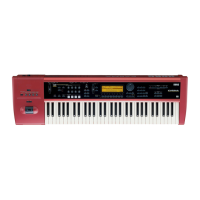52
Combination mode
In Combination mode you select, play and edit combi-
nations.
Combination mode consists of pages 1.1: Play–7.3: Ed-
MasterFX.
In 1.1: Play you can select and play combinations. You
can also do some overall editing, and make KARMA
function settings (☞p.29).
In 2.1: Ed-Basic–7.3: Ed-MasterFX you can edit the
parameters of the combination that was selected in 1.1:
Play.
How a combination is organized
A combination consists of a variety of parameters that
can be accessed in 2.1: Ed-Basic–7.3: Ed-MasterFX. The
diagram below shows how a combination is struc-
tured.
Basic combination editing
Banks A, B and E of this instrument contain a wide
variety of combinations that use the preloaded pro-
grams (bank A, B and E) and KARMA function and
effects. You can edit these combinations, or create your
own original combinations from an initialized state.
A combination that you edited or created can be writ-
ten into one of 768 combination memory locations in
banks A–F. Combinations can also be stored or orga-
nized on external media such as floppy disk in Disk
mode. (☞p.38, p.40)
If a program being edited in Program mode is used
in a combination, it will sound according to the set-
tings being edited.
If you wish to save an edited combination in inter-
nal memory, you must write it. (☞p.38)
If the separately sold EXB-MOSS option is
installed, bank F programs can be used for the tim-
bres of a combination. For details on the parame-
ters of bank F programs, refer to the EXB-MOSS
owner’s manual and PG p.269.
Suggestions for editing procedure
The parameters of each timbre are set in 2.1: Ed-Prog/
Mix–4.4: MIDI Filter4, and 7.1:Ed-BUS. This is where
you create the basic combination consisting of the pro-
grams you select here.
First use 2.1: Ed-Prog/Mix to select the program for
each timbre, and then use 3.3: Ed-Key Zone and 3.4:
Ed-Vel Zone to specify the range in which each pro-
gram will sound (layer, split, velocity switch, etc.).
Then adjust the volume of each timbre, and set various
other parameters.
To add finishing touches to the sound, you can make
insert effect settings (in 7.2: Ed-Insert FX) and master
effect and master EQ settings (in 7.3: Ed-Master FX)
that are separate from the effect settings of Program
mode. In addition, you can make KARMA function set-
tings (in 6.1–6.4: Ed-KARMA.) and controller settings
(in 2.2: Ed-Ctrl) to create the finished combination.
By using the utility menu command “Solo Selected
Timbre”, you can listen only to the selected timbre.
This is a convenient way to audition individual
sounds of timbres that are layered. (☞p.35)
In pages that display all timbres 1–8, such as 2.1:
Ed-Prog/Mix, you can use the [ ] [ ] keys to
select timbres. You can also select timbres directly
by holding down the [TIMBRE/TRACK] key and
pressing one of the [F1
1/9]–[F8 8/16] keys.
Parameters
Parameters
Parameters
Parameters
Insert Effect 1 ... 5 :
7.2-1...6
AUDIO OUTPUT
L/MONO, R
Master Effect 1, 2 :
7.3-1...3
AUDIO OUTPUT
INDIVIDUAL 1,2
MasterEQ :7.3-4
Controller Setup : 2.2
KARMA: 6.1…4
(Module A, B, C, D)
Timbre2
Timbre3
Timbre8
Timbre4
BUS : 7.1-1
Timbre
Insert Effect
Master Effect
Individual Outputs
Timbre1
Parameters
Program
Program
Program
Program
Program
7.1-1 or 7.2-1 etc. indicate pages or tab screens used on this instrument for editing.

